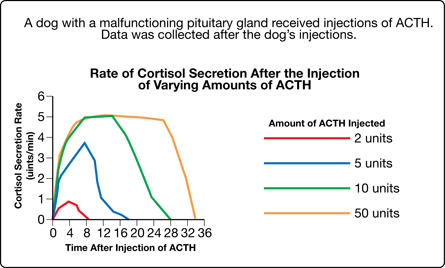Module 2
1. Module 2
1.24. Page 5
Module 2—The Endocrine System

© Peter Miller/iStockphoto
Aldosterone
 Read
Read
A second group of hormones produced by the adrenal cortex is called the mineralocorticoids, which include aldosterone. In Biology 20 you learned that aldosterone targets the distal and collecting tubules of the kidneys, resulting in an increase in the absorption of sodium into the blood. To review the role of aldosterone and how it contributes to maintaining homeostasis, read “Aldosterone” on page 454 in your textbook. Take point-form notes for your course folder as you read.
mineralocorticoid: a hormone produced by the adrenal cortex that regulates salt and water homeostasis by influencing the reabsorption of sodium ions
An example is aldosterone.
aldosterone: a hormone produced by the adrenal cortex in response to an increase in certain enzymes and high levels of ACTH; acts to increase sodium ion reabsorption
 Self-Check
Self-Check
To apply your understanding of how aldosterone contributes to homeostasis involving sodium ions and water, complete the questions SC 8, SC 9, and SC 10 using full sentences.
SC 8. What is the difference in the way that aldosterone and ADH affect water balance?
SC 9. Why are sodium ions important in the body?
SC 10. How does aldosterone help the body cope with an ongoing stressful situation? How is this response different from the fight-or-flight response?
Complete the following questions in preparation for the Lesson 3 Assignment. These questions consist of both multiple-choice and written-response questions. When you have finished, check your answers. If you do not understand any of the concepts, be sure to discuss them with your teacher.
SC 11. Increasing the levels of aldosterone in the blood would result in
- increased blood volume
- decreased blood pressure
- decreased heart rate
- increased urine production
SC 12. During an emergency situation, the adrenal gland is stimulated to release a hormone that directly causes an increase in
- sodium ion concentration
- blood glucose levels
- conversion of glucose to glycogen
- sympathetic nervous stimulation
SC 13. Returning involuntary body functions to normal after a period of stress is partly the function of the
- sympathetic nervous system
- parasympathetic nervous system
- tropic hormones such as ACTH
- releasing hormones from the hypothalamus
SC 14. A high blood cortisol level controls the secretion of
- adrenocorticotropic hormone and releasing hormone from the hypothalamus
- adrenocorticotropic hormone and releasing hormone from the anterior pituitary
- adrenocorticotropic hormone from the hypothalamus and releasing hormone from the anterior pituitary
- adrenocorticotropic hormone from the anterior pituitary and releasing hormone from the hypothalamus
SC 15. Which of the following is normally not part of the fight-or-flight response to short-term stress situations?
- increased blood glucose levels
- increased heart rate
- increased blood pressure
- increased blood volume
Use the following information to answer questions SC 16 and SC 17.
| Polygraphs (lie detectors) monitor certain changes in some activities of the nervous system. In theory, an emotionally stressful situation, like telling lies, will increase a person's perspiration, breathing rate, and heart rate and cause slight dilation of the pupils. However, polygraphs cannot exclusively differentiate between telling lies and other stressful situations. |
SC 16. The physiological changes that are associated with telling lies are responses produced by
- impulses from sympathetic nerves of the autonomic nervous system and hormones from the adrenal medulla
- impulses from sympathetic nerves of the autonomic nervous system and hormones from the adrenal cortex
- impulses from parasympathetic nerves of the autonomic nervous system and hormones from the adrenal medulla
- impulses from the parasympathetic nerves of the autonomic nervous system and hormones from both the adrenal medulla and the cortex
SC 17. Emotionally stressful situations may affect more than one system of the body. Another possible response produced by telling lies would be
- decreased secretion of ACTH
- increased secretion of aldosterone
- decreased secretion of cortisol
- increased secretion of epinephrine
Use the following information to answer question SC 18 and SC 19.
| Stressful situations trigger the release of hormones such as cortisol. Recent studies have found that some forms of depression cause a similar hormonal response that lasts much longer than the normal stress response. This unregulated release of stress hormones may result in reduced appetite, an unresponsive immune system, inadequate tissue repair, and insomnia. |
SC 18. Another stress hormone whose functions mimic those of the sympathetic nervous system is
- acetylcholine
- norepinephrine
- aldosterone
- insulin
Use the following additional information to answer the next question.

SC 19. A logical interpretation of the graph is that the
- secretion of cortisol is inhibited by increased ACTH
- secretion of cortisol is doubled if the secretion of ACTH is doubled
- adrenal glands respond more quickly to small amounts of ACTH than to large amounts of ACTH
- adrenal glands respond to large amounts of ACTH by having a maximum cortisol secretion rate
SC 20. The secretion of Hormone A causes an increase in Activity X in the body. If this mechanism works by positive feedback, which of the following statements is true?
- An increase in X produces an increase in A.
- An increase in A produces a decrease in X.
- An increase in X produces a decrease in A.
- A decrease in A produces an increase in X.
SC 21. Suppose you are lost in concentration while studying biology. Suddenly, the phone rings and startles you. Outline the physiological changes that occur in your body due to release of the stress hormones cortisol and epinephrine. What triggers the release of each of these hormones?
SC 22. The appropriate level of hormones circulating in the body is critical to proper homeostasis. If there is too much cortisol and aldosterone, a person develops Cushing’s disease. If there is too little of these hormones, a person develops Addison’s disease. Complete a table like the one below contrasting the two disorders
Contrasting Oversecretion and Undersecretion of Adrenal Cortex Hormones
Features |
Cushing’s Disease |
Addison’s Disease |
Hormones Involved |
|
|
Level of Hormones Secreted |
|
|
Cause of Inappropriate Level of Secretion |
|
|
Symptoms |
|
|
Treatment |
 Self-Check Answers
Self-Check Answers
SC 8. Aldosterone first increases reabsorption of sodium ions into the blood from the kidneys, causing an increase in solute concentration of the blood, which results in water reabsorption. ADH directly increases the permeability of cells in the nephrons of the kidneys to reabsorb more water.
SC 9. Sodium ions are very important in nerve impulse transmission (studied in Module 1), muscle contraction, and ion (electrolyte) balance in the body.
SC 10. Aldosterone targets the kidneys, where it promotes the renal absorption of sodium ions into the bloodstream. The resulting increase in the solute concentration of the blood draws more water from the nephrons in the kidneys, resulting in higher blood pressure. Higher blood pressure would be advantageous as a stress response because more oxygen and glucose from the blood would be made available to the tissues in less time. However, this response would take place over a much longer period of time than the fight-or-flight response and may prove to be harmful to the circulatory system if sustained for such long periods of time, resulting in increased risk of heart attack and atherosclerosis.
SC 11. A
SC 12. D
SC 13. B
SC 14. D
SC 15. D
SC 16. A
SC 17. D
SC 18. B
SC 19. D
SC 20. A
SC 21. When you are startled, the adrenal medulla is stimulated by neurons from the sympathetic nervous system to release the hormones epinephrine and norepinephrine. These hormones trigger an increase in breathing rate, heart rate, blood pressure, blood flow to the heart and muscles, and the conversion of glycogen to glucose in the liver. In other words, these hormones trigger all of the fight-or-flight responses. In addition, when the brain detects danger, it signals the hypothalamus to secrete a releasing hormone. The releasing hormone stimulates the anterior pituitary gland to secrete ACTH. ACTH stimulates the adrenal cortex to release cortisol. Cortisol intensifies the responses of epinephrine and norepinephrine, but is longer lasting. Cortisol also increases blood glucose by promoting the breakdown of proteins (amino acids) and fats to glucose (not by conversion of glycogen to glucose like epinephrine and norepinephrine).
SC 22. The completed table should have the following differences.
Features |
Cushing’s Disease |
Addison’s Disease |
Hormones Involved |
cortisol, aldosterone |
cortisol, aldosterone |
Level of Hormones Secreted |
too much |
too little |
Cause of Inappropriate Level of |
tumours in anterior pituitary, causing oversecretion of ACTH
OR tumours in adrenal cortex, causing oversecretion of cortisol and/or aldosterone |
destruction of cells in adrenal cortex (auto-immune disease) |
Symptoms |
excess accumulation of fat at back of neck (buffalo hump) or in puffiness of the face, causing a round or “moon” face, increased blood pressure, and decreased resistance to infections |
sodium ions not balanced, loss of water in urine, low blood glucose, decreased blood pressure |
Treatment |
surgery to remove tumours or radiation to shrink tumours, drugs to dampen effects of ACTH |
cortisol in the form of prednisone or hydrocortisone by mouth in tablet form |
Based on your success with the Self-Check, you may wish to practise some of the questions on page 455 of your textbook. Discuss your responses with your teacher.
 Module 2: Lesson 3 Assignment
Module 2: Lesson 3 Assignment
Retrieve the copy of the Module 2: Lesson 3 Assignment that you saved to your computer earlier in this lesson. Complete all questions. Save your completed assignment in your course folder. You will receive instructions about when to submit your assignment to your teacher later in this lesson.